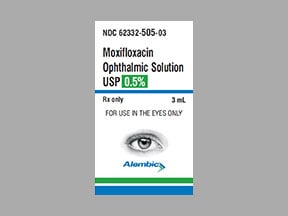
Vigamox Coupons & Savings Card – Discount Prices from $10.14
Brand for: Moxifloxacin
My prescription
Edit
3ML of 0.5%, Moxifloxacin (1 Bottle)
Select pharmacy

CVS
$19.46
COUPON PRICE
Walmart
$10.14
COUPON PRICE
Walgreens
$15.33
COUPON PRICE
Albertsons
$21.18
COUPON PRICEVigamox savings card
Show this card to your pharmacist
Walmart
$10.14
BIN
ID
PCN
GRP
019876
LHB113E1C4
CHIPPO
LHX
Powered by
Related quinolone antibiotics prescriptions
More prescriptions for eye infection
Related quinolone antibiotics prescriptions
More prescriptions for eye infection
Vigamox (Moxifloxacin) dosage forms
Dosage Quantity Price from Per unit 3ML of 0.5% 1 Bottle $10.14 $10.14 3ML of 0.5% 2 Bottles $17.78 $8.89 3ML of 0.5% 3 Bottles $22.37 $7.46
| Dosage | Quantity | Price from | Per unit |
|---|---|---|---|
| 3ML of 0.5% | 1 Bottle | $10.14 | $10.14 |
| 3ML of 0.5% | 2 Bottles | $17.78 | $8.89 |
| 3ML of 0.5% | 3 Bottles | $22.37 | $7.46 |
Vigamox Warnings
This document outlines crucial safety information regarding the use of this medication. Please read carefully and consult your healthcare provider with any questions or concerns.
Eye Application Only: Moxifloxacin (Vigamox) is intended solely for ocular use. Do not apply it to any other part of your body.
Risk of New Infections: Prolonged use of moxifloxacin (Vigamox) may lead to secondary infections by bacteria, fungi, or other organisms not responsive to the medication. If your eye infection persists, contact your healthcare provider for further evaluation and possible additional treatment.
Contact Lens Advisory: Avoid wearing contact lenses during an active bacterial eye infection, such as conjunctivitis. Discard any lenses worn prior to starting treatment as they may be contaminated. Consult your healthcare provider or optometrist regarding the appropriate time to resume wearing contact lenses after the infection has cleared.
Severe Allergic Reactions: Severe allergic reactions have been reported with other forms of moxifloxacin (such as oral or injectable). Symptoms may include facial swelling, shock, and anaphylaxis, manifesting as hives, rash, swelling of the lips or tongue, or difficulty breathing. Seek immediate medical attention if these symptoms occur. Individuals with a known allergy to fluoroquinolone antibiotics are at increased risk.
Contraindications: This medication should not be used by individuals with a severe allergy to fluoroquinolone antibiotics, as it poses significant health risks. Consult your healthcare provider if this applies to you.
Vigamox Side Effects
When using this medication, some individuals may experience common side effects such as eye inflammation or redness, blurry vision, dry eyes, eye irritation, pain, itching, or watery eyes. These effects are generally mild and often resolve on their own, but if they persist or worsen, it is advisable to consult a healthcare provider. In addition to eye-related effects, some users may report symptoms like cough, sore throat, runny nose, middle ear infection, or fever. Although these are not as common, they should be monitored and discussed with a healthcare provider if they become bothersome. On a more serious note, rare side effects can occur and require immediate medical attention. These include symptoms of a severe allergic reaction, such as hives, rash, difficulty breathing, or swelling of the face, tongue, or throat. Swelling of the eye is another serious concern that should be addressed promptly. While this summary covers many potential side effects, it is not exhaustive. If you notice any other unusual symptoms, reach out to a healthcare professional. Always use this medication as directed to minimize risks, including the potential for developing a new fungal eye infection with prolonged use.
Vigamox Interactions
Vigamox is an antibiotic eye drop used to treat bacterial eye infections. When applied as directed, it is generally safe and has minimal interactions with other medications. However, it's important to be aware of certain considerations:
Systemic Absorption: The amount of Moxifloxacin (the active ingredient in Vigamox) that enters the bloodstream from eye drops is very low. Therefore, it is unlikely to interact with other medications you may be taking.
Use with Other Eye Medications: If you're using multiple eye drops, it's advisable to wait at least 5 minutes between applications to ensure each medication is absorbed properly.
Contact Lenses: Avoid wearing contact lenses while treating an eye infection with Vigamox. Once the infection has cleared, use a fresh pair of lenses to prevent reinfection.
Vision Changes: Vigamox may cause temporary blurred vision after application. It's best to wait until your vision clears before driving or operating machinery.
Always inform your healthcare provider about all medications and supplements you're currently using to ensure safe and effective treatment.
What is Vigamox used to treat?
Vigamox is used to treat bacterial infections of the eye, such as bacterial conjunctivitis.
Is Vigamox the same as ciprofloxacin?
Vigamox and ciprofloxacin are not the same. Vigamox contains the active ingredient moxifloxacin, which is a different type of fluoroquinolone antibiotic than ciprofloxacin. Both are used to treat bacterial infections, but they are distinct medications with different active ingredients.
Can Vigamox be used for pink eye?
Yes, Vigamox, which is an antibiotic eye drop, can be used to treat bacterial conjunctivitis, commonly known as pink eye. However, it is important for the individual to consult with a healthcare provider to ensure it is the appropriate treatment for their specific condition.
What are the benefits of Vigamox?
Vigamox is an antibiotic eye drop used to treat bacterial conjunctivitis, commonly known as pink eye. The benefits of Vigamox include its ability to effectively eliminate the bacteria causing the infection, reduce symptoms such as redness, irritation, and discharge, and promote faster healing of the eye. It is generally well-tolerated and provides targeted treatment directly to the affected area.
What do Vigamox eye drops treat?
Vigamox eye drops are used to treat bacterial conjunctivitis, which is an infection of the eye caused by bacteria.
